Your RV thermostat is an important part of what keeps you comfortable in your RV in all kinds of weather. Whether the ambient temperature is hot or cold, your RV thermostat is ready for climate control.
But like everything else, RV thermostats have a lifespan and at some point, you may find yourself with one that’s failed. In today’s post, we’re hoping to prepare you for that possibility, so that you’ll be ready if your RV’s thermostat needs to be replaced…because unfortunately, these things tend to happen at the most inopportune times!
So, let’s get to it!
- 1) What Is an RV Thermostat?
- 2) How Do RV Thermostats Work?
- 3) Do You Need a Special Thermostat for an RV?
- 4) Are RV Thermostats Different?
- 5) What Voltage Are RV Thermostats?
- 6) Why Do I Have 2 Thermostats in My RV?
- 7) Do RV Thermostats Go Bad?
- 8) How Do I Know If My RV Thermostat is Bad?
- 9) RV Thermostat Upgrade: Top Choices for 2022
- 10) Have You Upgraded or Replaced The Thermostat in Your RV?
What Is an RV Thermostat?
An RV thermostat controls the temperature in your RV by regulating your RV furnace and (in modern RVs) the air conditioner(s)/heat pump(s) as well.
Just like at home, when you turn the thermostat to a certain temperature setting, the furnace (or AC unit) will respond by warming (or cooling) your RV accordingly.
How Do RV Thermostats Work?
An RV will generally have one or more thermostats to control both the cooling and heating functions. Again, just like in a home, when you adjust the temperature on the thermostat, your heater or air conditioner will respond by heating or cooling the interior to the designated temperature.
Do You Need a Special Thermostat for an RV?
Yes – you need a special thermostat for an RV because the electrical components are different from home thermostats. The voltages are different, the wiring is different, and the electronics involved in the HVAC appliances are different.
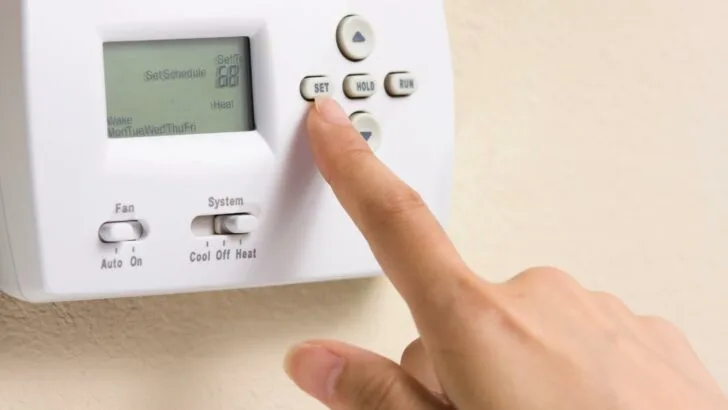
Thermostats need to be capable of working with both the heating and cooling systems in your RV.
When you buy a new thermostat for your RV, you’ll need to purchase one that’s specifically designed for RV use, and you’ll also need to ensure that it’s compatible with the HVAC equipment you already have installed.
For instance, if you have Dometic air conditioners, you’ll need a thermostat that’s compatible with the control electronics installed in them. Typically, that will mean using/installing the same brand of thermostat as your air conditioners and/or furnace. In many instances, air conditioners take precedent (and furnaces are less finicky).
That’s because the circuitry in the air conditioner may be integral to the entire HVAC system, allowing it to switch from Heat Pump mode (where the air conditioner is running a reversed cooling cycle to extract warmth from the ambient outside air and blow it inside the RV) to running the furnace if outside temps drop too low.
So before purchasing a new/replacement thermostat, be sure it will be compatible with your existing HVAC appliances.
Are RV Thermostats Different?
RV thermostats are different in style, type, and features.
You can choose an analog, digital, programmable, or even a smart thermostat for your RV.
RV Analog Thermostat
An analog RV thermostat is a basic and reliable choice, especially if you’re looking for one that’s easiest on the budget.
An analog RV thermostat has a little slider, generally on the bottom, that allows you to change the temperature settings.
Analog thermostats don’t require electrical power to operate, another reason why they’re a great choice for many RVers.
Digital RV Thermostat
With a digital RV thermostat, you’ll touch buttons to raise or lower the temperature settings which will display as precise numbers. This allows you to choose an exact temperature.
Digital thermostats require electrical power to operate their internal circuitry and to power their display panels. The required power is generally provided directly by the furnace wiring.
Programmable RV Thermostat
A programmable RV thermostat allows you to pre-program the times when you want your settings to take effect.
For example, if you want your furnace to kick on shortly before you return from skiing, you can program it to come on at that time and raise the temperature in your RV to your designated level. Likewise, if you want your air conditioning to cool your rig shortly before you return from a long summer hike, you can program it to do kick on at a designated time and cool your RV to your desired temperature.
RV Smart Thermostat
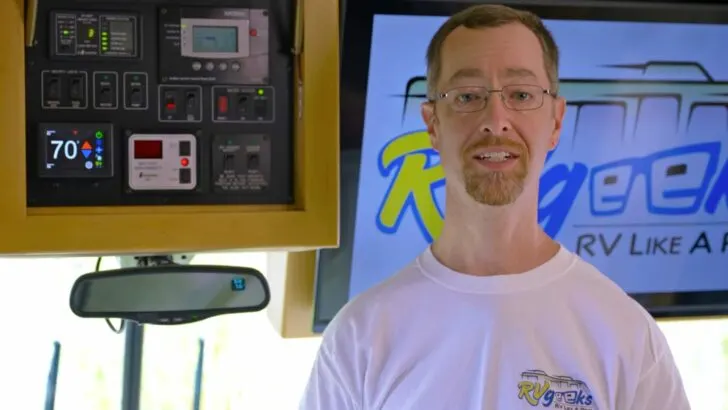
Here’s John standing beside our MicroAir EasyStart smart RV thermostat, explaining the system for a video we’ll link to below.
An RV smart thermostat typically will connect to the internet (over Wi-Fi or cellular… separate equipment and/or service plan may be required) to allow you to remotely adjust the heating and cooling temperature settings in your RV. This is typically achieved through the use of an app on your smart device.
Higher-end models will also enable you to integrate them with other “smart home” technologies, like Amazon Alexa, Google Nest, or Apple Home. Feeling a little chilly, ask Google to raise the temperature! ????
What Voltage Are RV Thermostats?
RV thermostats typically operate on the same 12V DC power as all other DC devices (lights, water pump, vent fans, etc) on your RV.
By contrast, a typical residential thermostat operates on 24V AC power.
Why Do I Have 2 Thermostats in My RV?
There can be a number of reasons why you have more than one thermostat in your RV. And that can vary by RV manufacturer and model.
Multiple Heating/Cooling Zones
One reason your RV has multiple thermostats could be to separately control a “zone” in your RV. The larger your RV is, the more likely it is to have separate heating/cooling areas. Front and back are the typical division, but it’s not uncommon to have even more. So each zone could have its own thermostat to both set and measure the temperature for that area.
Separate Heating & Air Conditioner Controls
Many RV manufacturers keep the wiring simpler by just installing a dedicated thermostat for each HVAC function: one for heat, and one for A/C. This can simplify the required wiring harness and/or make it easier for them to intermix brands/models of furnace and air conditioner, without worrying about compatibility.
Any Combination of the Above
Your RV manufacturer could have designed the HVAC system using a combination of the above issues. Your RV may have separate heating/cooling zones with multiple thermostats to control them. AND they may have one thermostat that controls both the heat/cooling for one zone (many RVs have only a single furnace for the whole RV, so heating isn’t split into “zones”), while the other zone(s) have a single unit that controls the A/C for that area.
Do RV Thermostats Go Bad?
Just like anything electrical/electronic, yes… they can malfunction for a variety of reasons, including wiring issues, dead batteries, or even dust. But a typical RV thermostat generally has a service life of around 10-15 years.
How Do I Know If My RV Thermostat is Bad?
There are several different issues that might occur to indicate that the thermostat in your RV is bad. Let’s take a look at them individually.
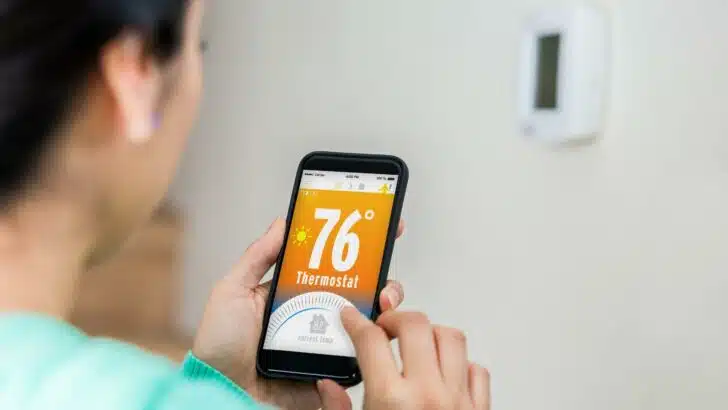
There are a number of issues that might indicate that your RV thermostat needs to be repaired or replaced.
Unresponsive Thermostat or Thermostat Loses Power
If your RV’s thermostat won’t turn on, it’s possible that the unit has lost power. This is actually a relatively common issue and may indicate that the unit has lost its connection to the electrical circuit. This generally means that the wiring is loose or has disconnected during travel. Check first at the back of the thermostat (the easiest spot), and then trace the wiring to its endpoint(s)… either the air conditioner or furnace (depending on your RV’s configuration).
Temperature Doesn’t Change
Another indication of a bad thermostat is if you adjust the settings and there’s no corresponding change in temperature. If the thermostat can’t identify the room temperature, then the unit can’t operate properly. This could indicate a failure of either the temperature control mechanism (mechanical or digital) or the temperature sensing capability (sometimes within the thermostat itself, other times from a “remote” sensor mounted elsewhere in the “zone” being controlled).
Battery Needs Replacing
Some (but not all) thermostats use a battery. If your thermostat is unresponsive, (and you’re sure the electrical system is fine), then this may indicate that the internal battery is dying. That’s an easy fix – just replace the battery. But if you replace the battery and the thermostat still doesn’t function, then the thermostat likely needs to be replaced… or one of the other potential failure points listed here is actually the cause.
Dim or Dead Display
If you have a digital thermostat with an LCD display and you notice a dim or missing display, this could also be an indication that your RV thermostat is on its last legs.
The Furnace or AC Runs Continuously and Won’t Switch Off
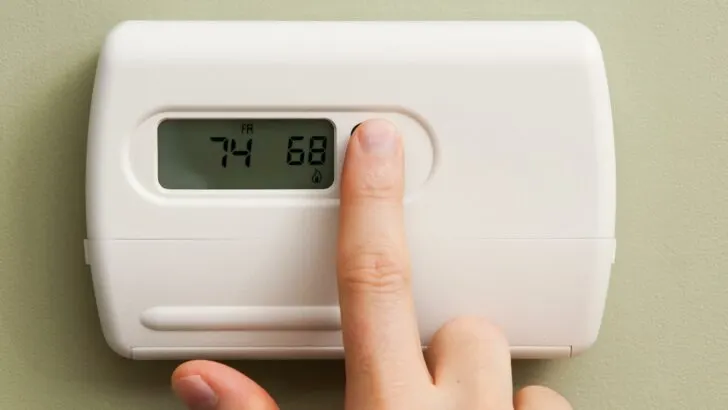
If your RV furnace or AC runs continuously, this may be a sign that your RV thermostat needs to be replaced.
If your RV furnace or air conditioner is constantly running and doesn’t turn off (even when you press the power button), it’s possible that the wiring is bad or the thermostat isn’t properly calibrated.
Another indication that your thermostat may require recalibration is if you turn up the thermostat and the temperature in the room doesn’t rise or cool properly.
However, this could also be an indication that the unit needs to be replaced.
The Temperature Setting Doesn’t Match the RV Temperature
If the reading on your RV thermostat doesn’t match the inside temperature, that may be an indication that it’s time to replace it. But, with some thermostats (particularly digital or smart RV thermostats), you can adjust a setting for how far above/below the set point it should allow the room temperature to swing. You may need to change this setting to keep it closer to the set point.
RV Thermostat Upgrade: Top Choices for 2022
Following are several of the top choices for RV thermostats on the market today.
Basic Dometic RV Thermostat – Analog
This is a basic analog RV thermostat found in millions of RVs on the road. It has manual controls and the temperature adjustments are made using the slider on the right-hand side of the unit.
This replacement RV analog thermostat by Dometic requires that the analog control board for this thermostat is already present. Note that this thermostat will not operate with a heat pump or heat strip.
- GENUINE OEM: Spare Parts for reliable and long-lasting performance.
- EASY TO INSTALL: This thermostat is the OEM replacement for the Euo-Therm 3106995.032 thermostat. Easy to use and install, this thermostat gives you...
Basic Coleman RV Thermostat – Analog
This is another basic analog RV thermostat with manual controls. This Coleman Mach RV thermostat is simple to install and use. It allows you to manually control your air conditioner, heat pump, gas, hydronic or electric strip heating, and fans from one convenient wall thermostat.
As with the previous analog unit, the temperature settings on the Coleman Mach are adjusted using the slider switch. The air temperature sensor activates heating or cooling as needed to maintain your desired temperatures inside your RV.
This unit also has manual switches to set cooling, heating, and fan speed settings individually.
Dometic Comfort Control 2 – Digital
Dometic’s DuoTherm Comfort Control 2 is a digital RV thermostat with a large, digital blue backlit display that is easy to read. Settings are adjusted with 12 click-response buttons that control up to four zones independently. A built-in sensor can monitor ambient temperature for control and management of your RV furnace, AC, heat pump, heat strip, or RV hydronic heating system.
This unit offers built-in error codes, an internal memory (to retain settings even in the event of loss of power), and the unit displays both actual and set temperatures.
- Built-in sensor accurate temperature control and management
- Large SMX blue light display is bright and easy-to-read, even in the dark
MicroAir EasyTouch – Smart Thermostat/RV Wireless Thermostat
The MicroAir EasyTouch Smart RV thermostat is a WiFi-enabled, Bluetooth-capable programmable wall thermostat. This unit’s color touchscreen can be operated directly or from a smartphone/tablet wherever cell service or WiFi is available (your RV must also have a WiFi network for the thermostat to connect to, and a connection to the internet, for remote access to work). The app is compatible with both Android and Apple devices.
The MicroAir EasyTouch is available in several models, each of which is designed to replace thermostats manufactured by Dometic and Coleman (and Atwood, coming soon). You can view the list of compatible RV thermostats on Micro-Air’s website.
All models are able to control any HVAC devices in your system, including air conditioners, heat pumps or heat strips, and furnaces (both standard propane versions or hydronic models).
The MicroAir EasyTouch is easy to install. You can learn much more about it in our full blog post on the MicroAir Each Touch, and in our corresponding YouTube video:
Micro-Air is offering RVgeeks’ viewers a discount on a new EasyTouch RV thermostat. Just use the discount code listed below when completing your purchase on Micro-Air’s website.
Looking to add some "smart home" features to your RV? How about a new color touchscreen, programmable thermostat? Even better, how about one that allows you to control it (even remotely) using a...Show More
Looking to add some "smart home" features to your RV? How about a new color touchscreen, programmable thermostat? Even better, how about one that allows you to control it (even remotely) using a smartphone or tablet? That's what the Micro-Air Easy Touch RV thermostat does.
Save $15 on each EasyTouch RV Thermostat when you buy direct from Micro-Air.
Show LessAnd if like us, you want to be able to run two air conditioners (or heat pumps) when plugged into 30-amp shore power, or if you have a smaller portable generator you’d like to be able to use to run a single air conditioner or heat pump, be sure to check out our video showing how to install the Micro-Air EasyStart soft start modules. They significantly reduce the start-up amperage required to get your A/C running.
And you can save $ on those, too!
Run your A/C from a small, portable generator OR run two A/C units on a 30-amp connection. By reducing the start-up current needed to get your A/C compressor running, the EasyStart 364 keeps you...Show More
Run your A/C from a small, portable generator OR run two A/C units on a 30-amp connection. By reducing the start-up current needed to get your A/C compressor running, the EasyStart 364 keeps you cool!
Watch our EasyStart installation video
Get $25 off each Micro-Air EasyStart 364 you buy factory direct using the code listed here.
Show LessFor anyone interested in more information on the MicroAir EasyStart, you can check out our post on that topic as well.
NOTE: If you want to order both an EasyStart and EasyTouch for your RV, you have to place separate orders to receive the discounts (it’s a limitation of Micro-Air’s e-commerce system). Orders placed one after another, shipping to the same address will be boxed together and will not cost extra to ship.
Have You Upgraded or Replaced The Thermostat in Your RV?
So, tell us – have you upgraded or replaced your RV thermostat? Which thermostat did you choose, and how’s it working for you? Let us know in the comments!
Geek Out with Us Every Week
Join our newsletter to learn about all things RV-related. Every week we offer free tips, tricks, product reviews, and more to our online community of RVers. So, whether this is your first time on the road or you’re a seasoned expert, we’d love for you to geek out with us!





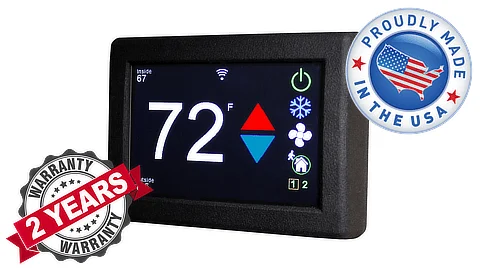
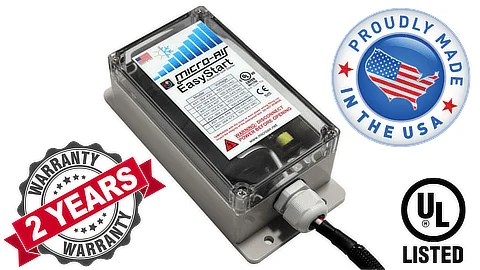
Karen
Monday 24th of April 2023
I bought a Coleman-Mach thermostat only to get home to find out mine was a Duo-therm!! What I would like to know is are they inter changeable? They are both analog
Lee
Friday 31st of March 2023
I currently have a Dometic system in my 2017 Escape 21. A/C and heat are controlled by the same thermostat. I have purchased a Houghton A/C unit, which has its own controls. I want to add an RV thermostat that ONLY controls the heater, but for the life of me can’t figure out how to set up the thermostat to control JUST heating. So: yes, I’ve purchased the new products but cannot make them work!
TheRVgeeks
Friday 31st of March 2023
Lee... typically, with RV's that have A/C and heating, the air conditioner's circuit board is what controls everything. Often, the furnace is wired to the A/C as well as the thermostat.
What you're probably going to need to do is to find the installation manual for your furnace and see what it says about wiring it as a standalone with its own thermostat. You'll likely need to run new wiring to an appropriate thermostat.
Harry
Friday 13th of January 2023
I recently replaced my Dometic analog thermostat with a Honeywell Focus Pro 5000 digital unit. It was an easy procedure using just 4 of the AC wires. The white for Furnace, the yellow for Cool, the green to one of the screws where the jumper bar connects the R and RC together, the tan or blue for Fan (The 5000 has only on fan speed. If you want both speeds I put in a On Off On switch in the wall below the thermostat) The 5000 has batteries so cap off the red wire as you do not need it. The AC / Furnace now operate as designed. So much more regulated than the Analog thermostat. If someone wants the exact HW model #, Email me. Harry
rag_ftw
Friday 24th of June 2022
Another reason the set temp varies from actual is the placement of the temp sensing units. One of mine was originally behind the TV causing the furnace to not come on or the a/c to run continuously. The heat from the TV was giving a false signal to the sensor. Moved the sensor below the TV and all is now well. My second sensor was mounted on an outside wall which didn't give a representative indication of the inside temp. Moved this one to an inside wall and now all is well. I might add that the temp sensors had lots of extra wiring so moving them was easy!
TheRVgeeks
Friday 24th of June 2022
It always amazes us where RV manufacturers place some things... thermostat sensors being one of them. Glad you found the solution to your problem... it's good for others to keep in mind. Thanks for sharing!